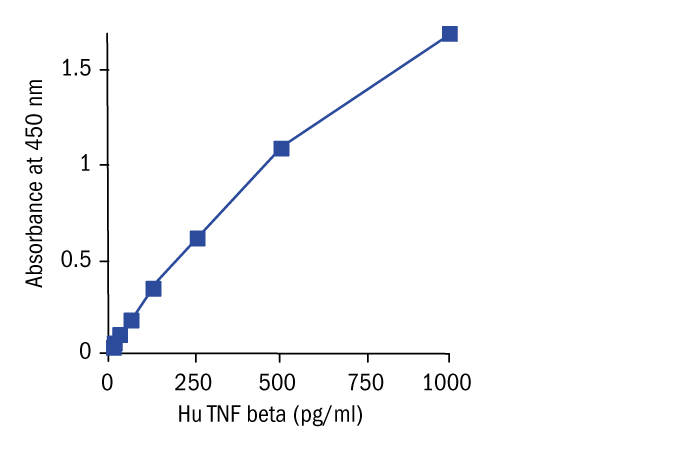Type
Sandwich ELISA, HRP-labelled antibody
Applications
Serum, Cell culture supernatant
Sample Requirements
100 µl/well
Shipping
At ambient temperature. Upon receipt, store the product at the temperature recommended below.
Storage/Expiration
Store the complete kit at 2–8°C. Under these conditions, the kit is stable until the expiration date (see label on the box).
Calibration Curve
Calibration Range
7.8–1000 pg/ml
Limit of Detection
4.6 pg/ml
Intra-assay (Within-Run)
CV = 8.0%
Inter-assay (Run-to-Run)
CV = 10%
Spiking Recovery
105.0 %
Research topic
Cytokines and chemokines and related molecules
Summary
Tumor Necrosis Factor (TNF) was originally discovered as a serum protein with necrotizing effects on certain transplantable mouse tumors in vivo and cytotoxic effects against some transformed cells in vitro. The TNF family consists of two proteins designated TNF-a, also called cachectin, and TNF-b, also called lymphotoxin, which are pleiotropic cytokines that can mediate a wide variety of biological effects.
TNF-b is produced by activated lymphocytes, whereas TNF-a is mostly produced by activated macrophages. Soluble TNF-b is a T-cell derived glycoprotein of 25 kD encoded by a gene within the MHC. The molecule consists of a 17.5 to 18 kD polypeptide core and 7kD of N-linked carbohydrate. TNF-b is 28 % structurally homologous with the macrophage produced nonglycoprotein TNF-a. The genes for TNF-a and TNF-b are closely linked, and the proteins share biological activities. TNF has been shown to interact with a cell through specific highaffinity receptors with a few hundred up to more than 20.000 copies per cell. In a variety of cell
lines, two different TNF-receptor proteins have been identified and the cDNAs cloned. Recently, an ELISA has been established by Adolf and Apfler which provides a simple, rapid, and highly sensitive method for the determination of soluble TNF-R (60 kDa) levels in body fluids or cell culture supernatants.
TNF-b is induced in an antigen-specific MHC restricted fashion from class I and class II restricted T cells. Viral infection is also associated with TNF-b production by lymphoid cells. TNF-b has several effects on target cells including killing, growth stimulation, induction of adhesion molecule (ICAM-1) expression, and induction of differentiation. The mechanisms of TNF-b effects involve receptor binding and internalization and several sequelae including changes in prostaglandins and chromosome integrity. TNF-b participates in tumor immunity,
and it has been reported to inhibit carcinogenesis as well as growth of some tumors in vivo. Recent studies have demonstrated that both TNF-a and TNF-b are capable of activating neutrophils in vitro. The exposure of neutrophils to TNF-a or TNF-b causes the production of superoxide radicals, induces phagocytic response and enhances antibody dependent cell cytotoxicity. The release of IL-1 from Human endothelial cells is also induced by TNF-a and TNF-b. All the in vitro studies suggest that TNF-b may play an important role in immunoregulation. In fibroblasts TNF-b induces the synthesis of colony-stimulating factors, IL-1, collagenase and prostaglandin-E2. Monocytes are stimulated for terminal differentiation. On B-cells TNF-b acts as mitogen. As TNF-b exerts proliferative capacity on fibroblasts it may participate in the process of wound healing.
Find documents for the lot
Example Instructions for Use (RUO)
Example Instructions for Use (RUO)
Safety Information (RUO)
MSDS (RUO)

